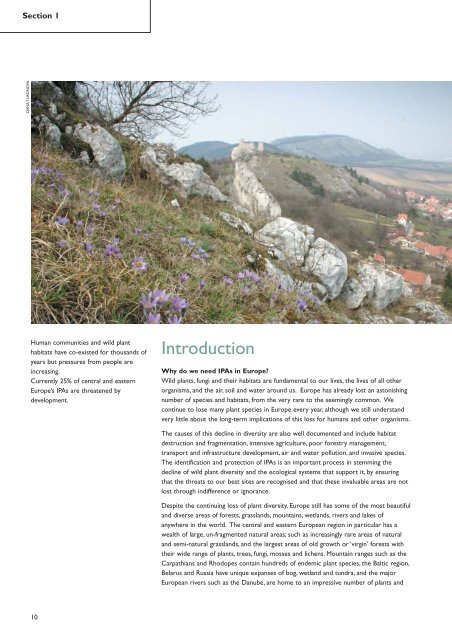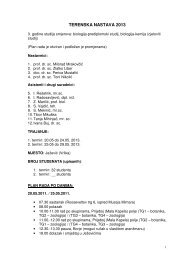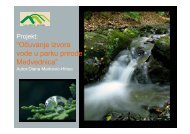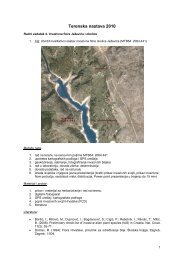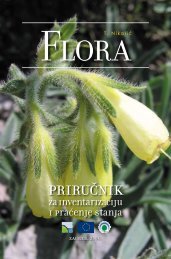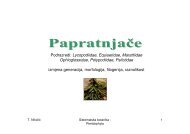important plant areas in central and eastern europe - hirc.botanic.hr ...
important plant areas in central and eastern europe - hirc.botanic.hr ...
important plant areas in central and eastern europe - hirc.botanic.hr ...
You also want an ePaper? Increase the reach of your titles
YUMPU automatically turns print PDFs into web optimized ePapers that Google loves.
Section 1DANA TURONOVAHuman communities <strong>and</strong> wild <strong>plant</strong>habitats have co-existed for thous<strong>and</strong>s ofyears but pressures from people are<strong>in</strong>creas<strong>in</strong>g.Currently 25% of <strong>central</strong> <strong>and</strong> <strong>eastern</strong>Europe’s IPAs are t<strong>hr</strong>eatened bydevelopment.IntroductionWhy do we need IPAs <strong>in</strong> Europe?Wild <strong>plant</strong>s, fungi <strong>and</strong> their habitats are fundamental to our lives, the lives of all otherorganisms, <strong>and</strong> the air, soil <strong>and</strong> water around us. Europe has already lost an astonish<strong>in</strong>gnumber of species <strong>and</strong> habitats, from the very rare to the seem<strong>in</strong>gly common. Wecont<strong>in</strong>ue to lose many <strong>plant</strong> species <strong>in</strong> Europe every year, although we still underst<strong>and</strong>very little about the long-term implications of this loss for humans <strong>and</strong> other organisms.The causes of this decl<strong>in</strong>e <strong>in</strong> diversity are also well documented <strong>and</strong> <strong>in</strong>clude habitatdestruction <strong>and</strong> fragmentation, <strong>in</strong>tensive agriculture, poor forestry management,transport <strong>and</strong> <strong>in</strong>frastructure development, air <strong>and</strong> water pollution, <strong>and</strong> <strong>in</strong>vasive species.The identification <strong>and</strong> protection of IPAs is an <strong>important</strong> process <strong>in</strong> stemm<strong>in</strong>g thedecl<strong>in</strong>e of wild <strong>plant</strong> diversity <strong>and</strong> the ecological systems that support it, by ensur<strong>in</strong>gthat the t<strong>hr</strong>eats to our best sites are recognised <strong>and</strong> that these <strong>in</strong>valuable <strong>areas</strong> are notlost t<strong>hr</strong>ough <strong>in</strong>difference or ignorance.Despite the cont<strong>in</strong>u<strong>in</strong>g loss of <strong>plant</strong> diversity, Europe still has some of the most beautiful<strong>and</strong> diverse <strong>areas</strong> of forests, grassl<strong>and</strong>s, mounta<strong>in</strong>s, wetl<strong>and</strong>s, rivers <strong>and</strong> lakes ofanywhere <strong>in</strong> the world. The <strong>central</strong> <strong>and</strong> <strong>eastern</strong> European region <strong>in</strong> particular has awealth of large, un-fragmented natural <strong>areas</strong>; such as <strong>in</strong>creas<strong>in</strong>gly rare <strong>areas</strong> of natural<strong>and</strong> semi-natural grassl<strong>and</strong>s, <strong>and</strong> the largest <strong>areas</strong> of old growth or ‘virg<strong>in</strong>’ forests withtheir wide range of <strong>plant</strong>s, trees, fungi, mosses <strong>and</strong> lichens. Mounta<strong>in</strong> ranges such as theCarpathians <strong>and</strong> Rhodopes conta<strong>in</strong> hundreds of endemic <strong>plant</strong> species, the Baltic region,Belarus <strong>and</strong> Russia have unique expanses of bog, wetl<strong>and</strong> <strong>and</strong> tundra, <strong>and</strong> the majorEuropean rivers such as the Danube, are home to an impressive number of <strong>plant</strong>s <strong>and</strong>10


